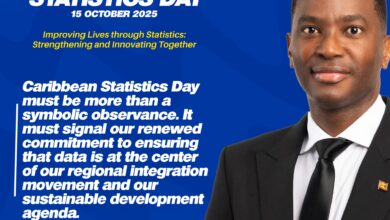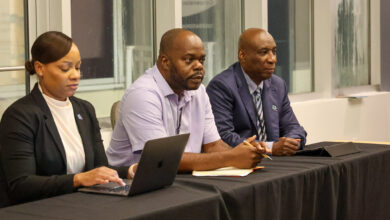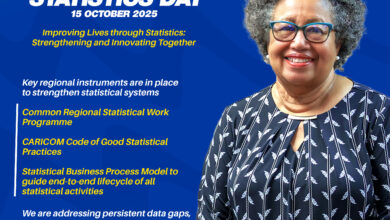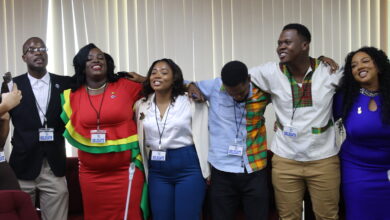Hon. Samuel Hinds, Prime Minister of Guyana
Hon. Mr. Justice Carl Singh, Chancellor of the Judiciary
Hon. Ralph Ramkarran, Speaker of the National Assembly
Hon. Samuel Insanally, Minister of Foreign Affairs and of CARICOM Affairs
Other Distinguished Ministers of Government
Members of the Diplomatic Corps
Other Distinguished Guests
Residents of Turkeyen
Staff of the Secretariat
Members of the Media
Ladies and Gentlemen:
A very special welcome to you all in this the year of the Inauguration of the Permanent Headquarters of the Secretariat of the Caribbean Community, and the Year of the Single Market. I am sure that you all have noticed the ordering of things here today.
Very seriously, I am particularly pleased to have all of you here with the staff of the Secretariat and their families, to celebrate today CARICOM Day 2005, which fell on the 4 July.
This year, 2005, is one which marks a new dawn for CARICOM. Apart from the two milestones just mentioned – namely the year of the CARICOM Single Market and the Inauguration of our Headquarters, and they are of great significance to the future of our Community – other key events – including the inauguration of the Caribbean Court of Justice (CCJ) headquartered in Trinidad and Tobago and the inauguration of the headquarters of the Caribbean Community Climate Change Centre, headquartered in Belize, have also taken place this year.
Both the Court and the Centre constitute new critical elements of the Community representing as they do, central parts of the Single Market and Economy – the vehicle determined for the redesigning and redevelopment of our regional economy.
Distinguished Guests, Ladies and Gentlemen, while it is not my intention today to enter into an economic discourse, one cannot fail to observe and certainly cannot help or be indifferent to the process of the virtual dismantling of our traditional economic structures. In whichever direction we look, bananas, sugar, rum, rice, the story is the same. This very week the WTO axe came down on bananas. We will now face the likelihood of having to compete with the much cheaper product from Latin America, in our traditional major market the European Union (EU) where we now supply a mere 20 per cent in comparison to their 60 per cent. This is unacceptable to us and contrary to any spirit of cooperation with our Latin neighbours. Sugar as we know is already on the chopping block and rum and rice are virtually in intensive care.
Added to all this, oil prices are strangling us, climate change and the resulting hurricanes and storms are blowing us away and HIV/AIDS literally killing us. At the same time, we continue to face an annual regional food import bill of over US$3 billion, on average US$500 for every man woman and child. No wonder, according to the World Bank, we are the most highly indebted region in the world with seven of the ten most indebted states being countries of our Region.
With no general aid relief package as that provided to Africa available to us (save fortunately Guyana), and with our trade regime being cut off at the knees at it were, leaving no scope to trade our way out of debt, fundamental and structural change is therefore our only realistic hope for our survival.
Against that background you may quite rightly ask what are you therefore celebrating? There is still much we can and should. This is what our own Professor Clive Thomas had to say on this in his recent Sixth William Demas Lecture right here in Guyana in March:
“As a long standing critic of the Region’s development policies and practice, I believe it is fair to state it would be difficult for anyone to deny, with an objective frame of mind, that in general much economic development has been achieved in the Region. This can readily be seen, if we examine the outcomes based on universally accepted indicators of development: income, economic structure, health, education, safety-nets, governance and even perhaps quality of life.”
These are the very gains that are now in danger of being lost and it is to protect and enhance such gains that the CARICOM Single Market and Economy is being designed and directed. Designed to create a single regional economic space where not only goods but services, capital, skilled labour and entrepreneurship can move across the Region to engage in the competitive production of goods and services, not only for export but for regional utilisation as well – the CSME in essence aims to achieve the efficiency and productivity necessary to more than replace the preferences being lost, and with that to restructure our regional economy.
One is aware of the inequalities which total reliance on market forces can lead to. Professor Thomas again clearly pointed to these in our Caribbean context. However, not only the Treaty which establishes CARICOM, but the Heads of Government themselves in their last meeting in Saint Lucia, specifically mandated the preparation and implementation of a set of specially advantageous measures for those countries, regions and sectors of our economies which need special assistance as a result of the deepening integration process. One such measure, quite an important one, is the Development Fund provided for under Article 158 of the Revised Treaty of Chaguaramas. Guyana is considered likely to be eligible for some of that special assistance.
But the Region must also rationalise and intensify its production. Why for example not centralise most of the sugar production in the most efficient producer country? (You know which country that is.) This will certainly give rise to a lower unit cost and to greater production; why not intensify our productive processes by deeper processing of our own raw materials – sugar, bauxite, etc? Why leave the profitable regional cruise tourism sector totally to foreigners?
All of these approaches must be pursued while at the same time:
1. we strive to win new markets abroad, for example, hence our investment in a regional negotiating structure;
2. we preserve and expand the gains the Community has made in areas such as health, education, culture, disaster management, security and such fields; and
3. build new areas such as information technology for development,
In all of this, taking the population along, so that they will be full partners in the process, experiencing both the ups and downs.
It is to be the nucleus of the regional effort to grapple with these kinds of fundamental issues that the Secretariat has been provided with the New Headquarters Building. It is for the pursuit of this kind of task that the better surroundings and facilities which the Headquarters represents have been made available. And it is for that reason that we the intended occupants, are especially pleased on this Thirty-Second CARICOM Anniversary.
With a university only a stone’s throw away and with a Conference Centre virtually on its doorsteps, I personally cannot fail to be excited at the conjunctural element of the environment in which this Headquarters Building is placed. I await only the enhancement of the Ogle Airstrip to complete my vision of a critical regional complex here on the shoulders of South America as it were, which would place CARICOM and specifically Guyana at the centre of regional deliberations on hemispheric issues.
As the Community commences its thirty-third year, therefore, there are certainly many serious challenges to be overcome – I have not even mentioned the troubling issue of Haiti for example – but though these issues obtain, there are also a number of encouraging signs and signals which give hope for our future success.
A particularly symbolically encouraging recent development was the historic meeting between our Heads of Government and Leaders of Opposition immediately preceding the last meeting of the Heads of Government in Saint Lucia in July. It was a first for CARICOM and a first for any integration grouping as far as I am aware. I can tell you, taking a little tale out of school as it were, it was a good start and Guyana, your leaders were exemplary!
And so, Ladies and Gentlemen, today, taking everything into account, we thought that we should celebrate CARICOM Day 2005 by inviting members of the Guyanese society and other friends here in Guyana, to join us in marking this occasion and in thanking you for your support to date and like Oliver Twist, asking for a little more. In doing so, let me begin by once again paying tribute to his Excellency the President of Guyana and his Government who despite pressing national demands delivered on Guyana’s promise to provide a suitable Headquarters for the CARICOM Secretariat. We thank you most sincerely Mr. President.
We also extend once again our thanks to the government of Japan for their substantial contribution towards building this magnificent edifice. Similarly, we extend the same to the Government of Barbados whose provision of a lift will help us to take the maximum advantage of this structure.
Our gratitude also to the Design Team, Vikab Engineering Consultants Limited, (Prime Consultants and Civil/Structural Engineers); NLBA Limited, Architects; and ENCO Engineering Consultants (Service Engineers), the Contracting Firm S.A Nabi and Sons and all the workers involved. This building is indeed an advertisement of their collective skill and competence.
We also wish to place on record our gratitude to the management and staff of the Bank of Guyana, not least the Guards for their care and generosity, in providing a home for our headquarters over the first generation of the life of the Secretariat. Without this generosity, the Secretariat and the Community would have had a much more difficult beginning. Our thanks also go to the Government of India, Tata Infotech and the Secretariat’s ICT Team for the provision and installation of our IT System. Similar thanks must go to the special team organized by the Secretariat to advise on and determine the content of our information systems. You will hear more about making our building e-smart, later in the programme.
Our deep appreciation is extended as well, to the hard working members of the Guyana Telephone and Telegraph Company (GT&T) and the Guyana Power and Light Company (GPL) staff who have toiled round the clock to ensure that our telephone and electricity supply systems are up and functioning.
Finally, we pay a special tribute to our Administrative Services which spearheaded the mammoth task of moving us from six buildings to this single complex in three weeks, and the work continues.
Also, my sincere appreciation and thanks to all members of Staff for their cooperation during this relocation period as well as for their hard work and dedication over the past year.
Ladies and Gentlemen, at the Inauguration of this building, I extended on behalf of the staff of the Secretariat, an invitation to the Member States of the Community for the contribution of pieces of art to ensure that this home of the Secretariat is made “culturally homely”. Its extensive walls still anxiously await – and can more than adequately accommodate – the gifts of cultural artifacts reflective of the rich diversity of our Community’s cultural heritage. I want to take advantage of this occasion to thank those who have already responded and to reiterate this appeal to the others.
In closing, as we celebrate this CARICOM Day 2005, let us re-dedicate ourselves to the task of building our Community, so that generations to come will look with pride upon the “house of unity” that was well and solidly built by the Caribbean people, and to the principal role that Guyana played in that historic venture. Ladies and Gentlemen, in this spirit, we look forward to interacting with our new- found neighbours of Turkeyen/Liliendaal.
It is with these sentiments overflowing that, on behalf of the Caribbean Community, I invite you to join me in a toast: To His Excellency the President The Government and the people of The Co-Operative Republic of Guyana!





